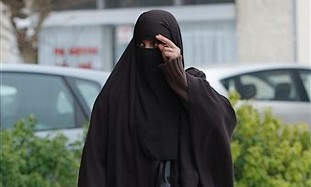
| THINK-ISRAEL |
| HOME | January-February 2010 Featured Stories | Background Information | News On The Web |
Litmus test for 'progressive Muslim' is how his sister and daughter are expected to behave.

The November 1958 edition of National Geographic included an article "The Arab World: A Story in Pictures." Among pictures of Palestinian refugees and UN workers helping them (some things haven't changed) was a photo of Tunisian women celebrating Independence Day. They were wearing less-than-flattering but nonetheless progressive white track suits with baseball caps in place of head scarves. The article waxed poetic on the "vivacious proof that modern Arabs no longer isolate women and insist they wear a veil... with their new status, women find opportunity." Photo captions noted that the veil was "conspicuous by its absence."
Anyone watching the Muslim world with a critical eye for the past half century would be hard pressed not to recognize that in every country, even supposedly secular Turkey, religiousness has increased, and women's dress has correspondingly become more conservative. Some would say the situation is more nuanced.
In Turkey, the elites have become more religious, while the rural Anatolian poor were religious and remain conservative. Only the public face is changing. Kamal al-Solaylee discussed just such a story in "From bikinis to burkas" in the Globe and Mail on January 9. In his version, the female members of his once-cosmopolitan family used to bathe in bikinis. Now they wear burkas and the men preach about religion.
Night clubs in Egypt ban women wearing full face veils, and when Saudi journalists "exposed" this fact, the Egyptians noted that the wearing of such veils was becoming more popular and that nightclubs didn't want these religious people dampening the fun. In Turkey there is an ever-increasing debate about allowing head-scarf-clad women into university, a bastion of secularism.
But there is another side to the increasing religiousness of Muslim women. What of the Muslim men? If one judges by their dress and behavior, it seems they haven't changed much in the past 60 years. If anything, Muslim men have become more liberal, more exposed to supposedly Western notions of beer-swilling promiscuity, and have acted accordingly.
This creates a disconnect between the supposedly liberal Muslim man and the conservative Muslim woman. Popular culture is at a loss to understand this contradiction. Instead, what people often say is that "Ahmed is liberal, he is a real progressive Muslim, he has a non-Muslim girlfriend and he drinks and dances and wears bathing suits and can discuss Sartre and Shakespeare and listens to Nelly."
CONSIDER THE Economist's description of Saudi Arabia's King Fahd. He studied the extremist version of Wahhabi Islam at a special school for the royal family. But "he liked the West, and Western pleasures in particular... One former ambassador recalls meeting him at an embassy party with a glass in one hand, a cigarette in the other and a Lebanese beauty on each arm." He was a good progressive, a real Westerner, except in his country women are whipped for being raped (their crime being described as "adultery") and are not permitted to drive or travel without the permission of a male relative.
An October 2009 National Geographic article entitled 'Facing Down the Fanatics' by Michael Finkel describes how Indonesia has become "more overtly Islamic" with the enactment of various forms of Shari'a law and modest dress by women. The most memorable picture from the article shows three men and a woman at a table. The men act as teenagers would in New York, one with a hoody, one with a colorful bracelet takes a long drag from a cigarette and one has an afro and a Simpsons shirt. But the woman is clothed head to toe in black, with only a tiny slit for her eyes.
The article further informs us that the magazine ME Asia is "challenging Indonesia's moral conservatism." A woman is shown with her bosom barely covered and in a red miniskirt posing for a photo. What the author doesn't reveal is that the model who is "challenging" this conservative society is not a Muslim but a member of the country's Chinese non-Muslim minority.
There is a disconnect in the West in its view of Islam. It once measured the community by how its women dressed. Now, since the women are all covered, it prefers to measure the community by how its men behave. Muslim male terrorists means Islamism is a threat. Boozing, carousing Muslim males working as bouncers at strip clubs (as Abu Hamza al-Masri, the London preacher did) are seen as good progressives. Oddly enough, the same Westerners who see their behavior as indicative of an embrace of "Western values" fail to laud Catholic or evangelical preachers who cheat on their wives and visit brothels as being progressives who represent a liberalizing influence over their peers.
The litmus test for the supposedly progressive Muslim is how his sister and daughter are expected to behave. Are they allowed out of the house past 8 p.m.? Can they date non-Muslims the way he does? Can they drink alcohol? What kinds of clothes can they wear? Can they swim beside the men at the pool or beach in similar bathing attire? The problem is that all too often Westerners don't even bother to notice Muslim women. Western women and men who visit Muslim countries treat Muslim women much as their own society too-often treats them, hiding them behind veils and ignoring their voices.
Seth J. Frantzman is a graduate student in Islamic and Middle
Eastern Studies, living in Jerusalem. Contact him at
sfrantzman@hotmail.com and visit his website:
http://journalterraincognita.blogspot.com
This article was published February 2, 2010 in Jerusalem Post
http://www.jpost.com/Opinion/Columnists/Article.aspx?id=167617
| HOME | January-February 2010 Featured Stories | Background Information | News On The Web |